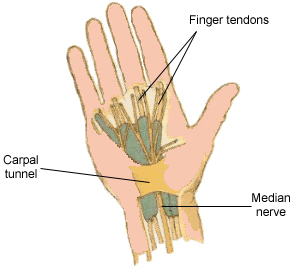- What is Carpal Tunnel Syndrome
- Statistics on Carpal Tunnel Syndrome
- Risk Factors for Carpal Tunnel Syndrome
- Progression of Carpal Tunnel Syndrome
- Symptoms of Carpal Tunnel Syndrome
- Clinical Examination of Carpal Tunnel Syndrome
- How is Carpal Tunnel Syndrome Diagnosed?
- Prognosis of Carpal Tunnel Syndrome
- How is Carpal Tunnel Syndrome Treated?
- Carpal Tunnel Syndrome References
What is Carpal Tunnel Syndrome
Carpal tunnel syndrome (CTS) is a common painful disorder caused by compression of the median nerve within the wrist. CTS is characterised by pain, numbness and weakness in the parts of the hand supplied by the median nerve. People with CTS may complain of “pins and needles” in the thumb, index and middle fingers, and half of the ring finger, as well as pain in the wrist.
The carpal tunnel is a narrow, rigid passageway of ligament and bones below the wrist at the heel of the hand which houses the median nerve and tendons. The carpal tunnel is normally quite snug, and there is just enough room in it for the tendons and nerves that have to pass through it. If anything takes up extra room in the canal (such as inflammatory swelling or injury), the nerve in the canal becomes compressed or “pinched”. This leads to CTS symptoms.
Statistics on Carpal Tunnel Syndrome
CTS is a common condition that occurs in 2.7% of the general population. It is more common in women than men, and the average age of people with CTS is 40–50 years.
Risk Factors for Carpal Tunnel Syndrome
A specific cause for CTS is rarely identified. However, a variety of risk factors may contribute to the development of the condition:
- Heredity: Approximately 50% of the risk is determined in the genes
- Overuse, work situations requiring rapid finger and wrist motions
- Wrist injury
- Diabetes mellitus
- Pregnancy and fluid accumulation states
- Hypothyroidism
- Rheumatoid arthritis and other joint disorders
- Menopause
- Acromegaly
- Systemic inflammation
- End-stage renal disease and dialysis
Progression of Carpal Tunnel Syndrome

With time, often there is progressive loss of coordination and strength in the thumb, and difficulty performing fine movements of the thumb as well as fine movements of the first to third digits.
With more persistent and severe squeezing or compression of the nerve, there may be wasting of some muscles of the hand.
How is Carpal Tunnel Syndrome Diagnosed?
The symptoms of nocturnal pain and numbness in the affected hand, as well as clinical signs, point towards diagnosis. A nerve conduction study is very useful to help confirm the diagnosis.
Blood tests may be useful to rule out other associated conditions (e.g. diabetes, rheumatoid arthritis, thyroid disease).
Imaging studies are sometimes required. X-rays are only of value in the presence of evidence of injury, fracture or bone changes. Ultrasound is occasionally used.
Prognosis of Carpal Tunnel Syndrome
Prognosis with surgery is very good, with 90% of patients obtaining long lasting relief from CTS symptoms.
How is Carpal Tunnel Syndrome Treated?

- Resting the wrist for a period of time in a wrist splint may help all causes.
- Physical therapy.
- For work-related CTS: Modifying activities and work habits.
- Anti-inflammatory medications; steroid injection into the wrist.
- Treating a related medical condition that may be causing CTS symptoms.
- Surgery to release the carpal tunnel has a high rate of success in most cases.
Article kindly reviewed by:
Associate Professor Karl Ng MB BS (Hons I) FRCP FRACP PhD CCT Clinical Neurophysiology (UK) Consultant Neurologist – Sydney North Neurology and Neurophysiology (download referral form and map); Conjoint Associate Professor – Sydney Medical School, University of Sydney; and Editorial Advisory Board Member of the Virtual Neuro Centre.
Carpal Tunnel Syndrome References
- Apley AG, Solomon L. Concise System of Orthopaedics and Fractures (2nd edition). London: CRC Press; 1994.
- Atroshi I, Gummesson C, Johnsson R, et al. Prevalence of carpal tunnel syndrome in a general population. JAMA. 1999;282(2):153-8. [Abstract | Full text]
- Ezzat S, Forster MJ, Berchtold P, et al. Acromegaly: Clinical and biochemical features in 500 patients. Medicine (Baltimore). 1994;73(5):233-40. [Abstract | Full text]
- Hakim AJ, Cherkas L, El Zayat S, et al. The genetic contribution to carpal tunnel syndrome in women: A twin study. Arthritis Rheum. 2002;47(3):275-9. [Abstract | Full text]
- Kachel HG, Altmeyer P, Bladamus CA, Koch KM. Deposition of an amyloid-like substance as a possible complication of regular dialysis treatment. Contrib Nephrol. 1983;36:127-32. [Abstract | Full text]
- Padua L, Aprile I, Caliandro P, et al. Symptoms and neurophysiological picture of carpal tunnel syndrome in pregnancy. Clin Neurophysiol. 2001;112(10):1946-51. [Abstract | Full text]
- Pascual E, Giner V, Aróstegui A, et al. Higher incidence of carpal tunnel syndrome in oophorectomized women. Br J Rheumatol. 1991;30(1):60-2. [Abstract | Full text]
- Stevens JC, Beard CM, O’Fallon WM, Kurland LT. Conditions associated with carpal tunnel syndrome. Mayo Clin Proc. 1992;67(6):541-8. [Abstract | Full text]
- Sheon RP. Clinical manifestations and diagnosis of carpal tunnel syndrome [online]. UpToDate. 2005 [cited 5 January 2006]. Available from [URL link]
- Stevens JC, Smith BE, Weaver AL, et al. Symptoms of 100 patients with electromyographically verified carpal tunnel syndrome. Muscle Nerve. 1999;22(10):1448-56. [Abstract | Full text]
All content and media on the HealthEngine Blog is created and published online for informational purposes only. It is not intended to be a substitute for professional medical advice and should not be relied on as health or personal advice. Always seek the guidance of your doctor or other qualified health professional with any questions you may have regarding your health or a medical condition. Never disregard the advice of a medical professional, or delay in seeking it because of something you have read on this Website. If you think you may have a medical emergency, call your doctor, go to the nearest hospital emergency department, or call the emergency services immediately.








